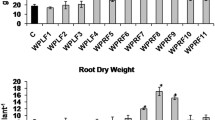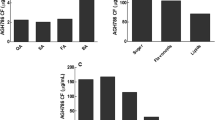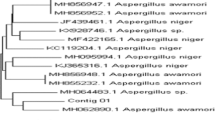Abstract
Endophytes have been reported from all plant species from different parts of tissue including root, stem and leaves. Here we report, three fungal endophytes, Aspergillus terreus strain 2aWF (2aWF), Penicillium oxalicum strain 5aWF (5aWF), and Sarocladium kiliense strain 10aWF (10aWF) from Withania somnifera, which could enhance withanolides content in leaf and root. Upon treatment with the above endophytes to 4 weeks old plants in field conditions, W. somnifera elicited withanolide A content (97 to 100%) in leaves without considerable changes in withaferin A content. Furthermore, withanolide A content in roots of 5aWF and 10aWF endophyte treated W. somnifera plants increased up to 52% and 65% respectively. Incidentally, expression profile of withanolide and sterol biosynthetic pathway genes HMGR, DXR, FPPS, SQS, SQE, CAS, SMT1, STE1 and CYP710A1 were significantly upregulated in 2aWF, 5aWF and 10aWF fungal endophyte treated plants. Besides, modulation of withanolide biosynthetic pathway genes, fungal endophytes also induce a host resistant related gene, NPR1 resulting in 2, 4 and 16 fold expression levels in 2aWF, 10aWF and 5aWF endophyte treatments respectively, compared to control plants. Overall, our results illustrate that application of native-fungal endophytes 2aWF (96.60%), 5aWF (95%) and 10aWF (147%) enhances plant biomass in addition to withanolide content.










Similar content being viewed by others

References
Ait Barka E, Nowak J, Clement C (2006) Enhancement of chilling resistance of inoculated grapevine plantlets with a plant growth-promoting rhizobacterium, Burkholderia phytofirmans strain PsJN. Appl Environ Microbiol 72:7246–7252. https://doi.org/10.1128/AEM.01047-06
Babiychuk E, Bouvier-Nave P, Compagnon V, Suzuki M, Muranaka T, Van Montagu M, Kushnir S, Schaller H (2008) Albinism and cell viability in cycloartenol synthase deficient Arabidopsis. Plant Signal Behav 3:978–980
Carroll G (1988) Fungal endophytes in stems and leaves: from latent pathogen to mutualistic symbiont. Ecology 69:2–8. https://doi.org/10.2307/1943154
Closa M, Vranova E, Bortolotti C, Bigler L, Arro M, Ferrer A, Gruissem W (2010) The Arabidopsis thaliana FPP synthase isozymes have overlapping and specific functions in isoprenoid biosynthesis, and complete loss of FPP synthase activity causes early developmental arrest. Plant J 63:512–525. https://doi.org/10.1111/j.1365-313X.2010.04253.x
Dhar N, Razdan S, Rana S, Bhat WW, Vishwakarma R, Lattoo SK (2015) A decade of molecular understanding of Withanolide biosynthesis and in vitro studies in Withania somnifera (L.) Dunal: prospects and perspectives for pathway engineering. Front Plant Sci 27:1031. https://doi.org/10.3389/fpls.2015.01031
Dutt M, Barthe G, Irey M, Grosser J (2015) Transgenic citrus expressing an arabidopsis NPR1 gene exhibit enhanced resistance against Huanglongbing (HLB; Citrus Greening). PLoS ONE 11:e0137134. https://doi.org/10.1371/journal.pone.0147657
El-Fattah Adnan Dababat A, Alexander Sikora R (2007) Induced resistance by the mutualistic endophyte, Fusarium oxysporum strain 162, toward Meloidogyne incognita on tomato. J Biol Sci Tech 17:969–975
Fouda AH, Hassan SE, Eid AM, Ewais EE (2015) Biotechnological applications of fungal endophytes associated with medicinal plant Asclepias sinaica (Bioss.). Ann Agric Sci 60:95–104
Franken P (2012) The plant strengthening root endophyte Piriformospora indica: potential application and the biology behind. Appl Microbiol Biotechnol 96:1455–1464. https://doi.org/10.1007/s00253-012-4506-1
Gao FK, Dai CC, Liu XZ (2010) Mechanisms of fungal endophytes in plant protection against pathogens. Afr J Microbiol Res 4:1346–1351
Gouda S, Das G, Sen SK, Shin HS, Patra JK (2016) Endophytes: a treasure house of bioactive compounds of medicinal importance. Front Microbiol 7:1538. https://doi.org/10.3389/fmicb.2016.01538
Grover A, Samuel G, Bisaria VS, Sundar D (2013) Enhanced withanolide production by overexpression of squalene synthase in Withania somnifera. J Biosci Bioeng 115:680–685. https://doi.org/10.1016/j.jbiosc.2012.12.011
Han JY, In JG, Kwon YS, Choi YE (2009) Regulation of ginsenoside and phytosterol biosynthesis by RNA interferences of squalene epoxidase gene in Panax ginseng. Phytochemistry 71:36–46. https://doi.org/10.1016/j.phytochem.2009.09.031
Hankin L, Zucker M, Sands DC (1971) Improved solid medium for the detection and enumeration of pectolytic bacteria. Appl Microbiol 22:205–209
Hardoim PR, van Overbeek LS, Elsas JD (2008) Properties of bacterial endophytes and their proposed role in plant growth. Trends Microbiol 16:463–471. https://doi.org/10.1016/j.tim.2008.07.008
Hiruma K, Gerlach N, Sacristan S, Nakano RT, Hacquard S, Kracher B, Neumann U, Ramirez D, Bucher M, O’Connell RJ, Schulze-Lefert P (2016) Root endophyte Colletotrichum tofieldiae confers plant fitness benefits that are phosphate status dependent. Cell 165:464–474. https://doi.org/10.1016/j.cell.2016.02.028
Hoffman MT, Gunatilaka MK, Wijeratne K, Gunatilaka L, Arnold AE (2013) Endohyphal bacterium enhances production of indole-3-acetic acid by a foliar fungal endophyte. PLoS ONE 8:e73132. https://doi.org/10.1371/journal.pone.0073132
Holmberg N, Harker M, Wallace AD, Clayton JC, Gibbard CL, Safford R (2003) Co-expression of N-terminal truncated 3-hydroxy-3-methylglutaryl CoA reductase and C24-sterol methyltransferase type 1 in transgenic tobacco enhances carbon flux towards end-product sterols. Plant J 36:12–20
Hosny MH, Farouk HH (2012) Protective effect of Withania somnifera against radiation-induced hepatotoxicity in rats. Ecotoxicol Environ Saf 80:14–19. https://doi.org/10.1016/j.ecoenv.2012.02.003
Jadaun JS, Sangwan NS, Narnoliya LK, Singh N, Bansal S, Mishra S, Sangwan RS (2016) Over-expression of DXS gene enhances terpenoidal secondary metabolite accumulation in rose-scented geranium and Withania somnifera: active involvement of plastid isoprenogenic pathway in their biosynthesis. Physiol Plantarum 59:381–400. https://doi.org/10.1111/ppl.12507
Khan R, Shahzad S, Choudhary MI, Khan SA, Ahmad A (2010) Communities of endophytic fungi in medicinal plant Withania somnifera. Pak J Bot 42:1281–1287
Khan AL, Hamayun M, Kang SM, Kim YH, Jung HY, Lee JH, Lee IJ (2012) Endophytic fungal association via gibberellins and indole acetic acid can improve plant growth under abiotic stress: an example of Paecilomyces formosus LHL10. BMC Microbiol 12:3. https://doi.org/10.1186/1471-2180-12-3
Khan AR, Ullah I, Waqas M, Shahzad R, Hong SJ, Park GS, Jung BK, Lee IJ, Shin JH (2015) Plant growth-promoting potential of endophytic fungi isolated from Solanum nigrum leaves. World J Microbiol Biotechnol 31:1461–1466. https://doi.org/10.1007/s11274-015-1888-0
Kumar A, Patil D, Rajamohanan PR, Ahmad A (2012) Isolation, purification and characterization of vinblastine and vincristine from endophytic fungus Fusarium oxysporum isolated from Catharanthus roseus. PLoS ONE 8:e71805. https://doi.org/10.1371/journal.pone.0071805
Kumar S, Kaushik N, Proksch P (2013) Identification of antifungal principle in the solvent extract of an endophytic fungus Chaetomium globosum from Withania somnifera. Springerplus 2:37. https://doi.org/10.1186/2193-1801-2-37
Kusari S, Verma VC, Lamshoeft M, Spiteller M (2012) An endophytic fungus from Azadirachta indica A. Juss. that produces azadirachtin. World J Microbiol Biotechnol 28:1287–1294. https://doi.org/10.1007/s11274-011-0876-2
Lata R, Chowdhury S, Gond SK, White JF Jr (2018) Induction of abiotic stress tolerance in plants by endophytic microbes. Lett Appl Microbiol 66:268–276. https://doi.org/10.1111/lam.12855
Leon-Reyes A, Spoel SH, De Lange ES, Abe H, Kobayashi M, Tsuda S, Millenaar FF, Welschen RA, Ritsema T, Pieterse CM (2009) Ethylene modulates the role of NONEXPRESSOR OF PATHOGENESIS-RELATED GENES1 in cross talk between salicylate and jasmonate signaling. Plant Physiol 149:1797–1809. https://doi.org/10.1104/pp.108.133926
Lichtenthaler HK, Wellburn AR (1971) Determinations of total carotenoids and chlorophylls a and b of leaf extracts in different solvents. Biochem Soc Trans 11:591–592. https://doi.org/10.1042/bst0110591
Livak KJ, Schmittgen TD (2001) Analysis of relative gene expression data using real-time quantitative PCR and the 2-∆∆Ct method. Methods 25:402–408. https://doi.org/10.1006/meth.2001.1262
Maggini V, De LM, Mengoni A, Gallo ER, Miceli E, Reidel RVB, Biffi S, Pistelli L, Fani R, Firenzuoli F, Bogani P (2017) Plant-endophytes interaction influences the secondary metabolism in Echinacea purpurea (L.) Moench: an in vitro model. Sci Rep 7:16924. https://doi.org/10.1038/s41598-017-17110-w
Mirjalili MH, Moyano E, Bonfill M, Cusido RM, Palazon J (2009) Steroidal lactones from Withania somnifera, an ancient plant for novel medicine. Molecules 14:2373–2393. https://doi.org/10.3390/molecules14072373
Mishra S, Bansal S, Mishra B, Sangwan RS, Asha, Jadaun JS, Sangwan NS (2016) RNAi and homologous over-expression based functional approaches reveal triterpenoid synthase gene-cycloartenol synthase is involved in downstream withanolide biosynthesis in Withania somnifera. PLoS ONE 11: e0149691. https://doi.org/10.1371/journal.pone.0149691
Mishra A, Singh SP, Mahfooz S, Singh SP, Bhattacharya A, Mishra N, Nautiyal CS (2018a) Endophyte-mediated modulation of defense-responsive genes and systemic resistance in Withania somnifera (L.) Dunal under Alternaria alternata stress. Appl Environ Microbiol. https://doi.org/10.1128/AEM.02845-17
Mishra A, Singh SP, Mahfooz S, Bhattacharya A, Mishra N, Shirke PA, Nautiyal CS (2018b) Bacterial endophytes modulates the withanolide biosynthetic pathway and physiological performance in Withania somnifera under biotic stress. Microbiol Res 212–213:17–28
Molitor A, Kogel KH (2009) Induced resistance triggered by Piriformospora indica. Plant Signal Behav 4:215–216
Möller EM, Bahnweg G, Sandermann H, Geiger HH (1992) A simple and efficient protocol for isolation of high molecular weight DNA from filamentous fungi, fruit bodies, and infected plant tissues. Nucleic Acids Res 20:6115–6116
Ngamau CN, Matiru VN, Tani A, Muthuri CW (2014) Potential use of endophytic bacteria as biofertilizer for sustainable banana (Musa spp.) production. Afr J Hort Sci 8:1–11
Oteino N, Lally RD, Kiwanuka S, Lloyd A, Ryan D, Germaine KJ, Dowling DN (2015) Plant growth promotion induced by phosphate solubilizing endophytic Pseudomonas isolates. Front Microbiol 6:745. https://doi.org/10.3389/fmicb.2015.00745
Pal S, Yadav AK, Singh AK, Rastogi S, Gupta MM, Verma RK, Nagegowda DA, Pal A, Shasany AK (2016) Nitrogen treatment enhances sterols and withaferin A through transcriptional activation of jasmonate pathway, WRKY transcription factors, and biosynthesis genes in Withania somnifera (L.) Dunal. Protoplasma 254:389–399 https://doi.org/10.1007/s00709-016-0959-x
Pandey V, Niranjan A, Atri N, Chandrashekhar K, Mishra MK, Trivedi PK, Misra P (2014) WsSGTL1 gene from Withania somnifera, modulates glycosylation profile, antioxidant system and confers biotic and salt stress tolerance in transgenic tobacco. Planta 239:1217–1231. https://doi.org/10.1007/s00425-014-2046-x
Pandey SS, Singh S, Babu CS, Shanker K, Srivastava NK, Kalra A (2016a) Endophytes of opium poppy differentially modulate host plant productivity and genes for the biosynthetic pathway of benzylisoquinoline alkaloids. Planta 243:1097–1114. https://doi.org/10.1007/s00425-016-2467-9
Pandey SS, Singh S, Babu CS, Shanker K, Srivastava NK, Shukla AK, Kalra A (2016b) Fungal endophytes of Catharanthus roseus enhance vindoline content by modulating structural and regulatory genes related to terpenoid indole alkaloid biosynthesis. Sci Rep 6:26583. https://doi.org/10.1038/srep26583
Patel N, Patel P, Kendurkar SV, Thulasiram HV, Khan BM (2015) Overexpression of squalene synthase in Withania somnifera leads to enhanced withanolide biosynthesis. Plant Cell Tissue Organ Cult 122:409–420
Pikovskaya RI (1948) Mobilization of phosphorus in soil in connection with vital activity of some microbial species. Microbiologiya 17:362–370
Qadri M, Johri S, Shah BA, Khajuria A, Sidiq T, Lattoo SK, Abdin MZ, Riyaz-Ul-Hassan S (2013) Identification and bioactive potential of endophytic fungi isolated from selected plants of the Western Himalayas. Springerplus 2:8. https://doi.org/10.1186/2193-1801-2-8
Raghavan A, Shah ZA (2015) Withania somnifera: a pre-clinical study on neuroregenerative therapy for stroke. Neural Regen Res 10:183–185. https://doi.org/10.4103/1673-5374.152362
Rai M, Acharya D, Singh A, Varma A (2001) Positive growth responses of the medicinal plants Spilanthes calva and Withania somnifera to inoculation by Piriformospora indica in a field trial. Mycorrhiza 11:123–128. https://doi.org/10.1007/s005720100115
Rana S, Bhat WW, Dhar N, Pandith SA, Razdan S, Vishwakarma R, Lattoo SK (2014) Molecular characterization of two A-type P450s, WsCYP98A and WsCYP76A from Withania somnifera (L.) Dunal: expression analysis and withanolide accumulation in response to exogenous elicitations. BMC Biotechnol 14:89. https://doi.org/10.1186/s12896-014-0089-5
Rodriguez RJ, Henson J, Van VE, Hoy M, Wright L, Beckwith F, Kim YO, Redman RS (2008) Stress tolerance in plants via habitat-adapted symbiosis. ISME J 2:404–416. https://doi.org/10.1038/ismej.2007.106
Saema S, ur Rahman L, Niranjan A, Ahmad IZ, Misra P (2015) RNAi-mediated gene silencing of WsSGTL1 in W. somnifera affects growth and glycosylation pattern. Plant Signal Behav 10:e1078064. https://doi.org/10.1080/15592324.2015
Salini TS, Dibu D, Shabanamol S, Sharrel R, Jisha MS (2014) Antimicrobial and immunomodulatory potential of endophytic fungus fusarium solani isolated from Withania somnifera. WJPR 10:879–890
Schulz B, Boyle C (2005) The endophytic continuum. Mycol Res 109:661–686
Seo JW, Jeong JH, Shin CG, Lo SC, Han SS, Yu KW, Harada E, Han JY, Choi YE (2005) Overexpression of squalene synthase in Eleutherococcus senticosus increases phytosterol and triterpene accumulation. Phytochemistry 66:869–877. https://doi.org/10.1016/j.phytochem.2005.02.016
Singh S, Pal S, Shanker K, Chanotiya CS, Gupta MM, Dwivedi UN, Shasany AK (2014) Sterol partitioning by HMGR and DXR for routing intermediates toward withanolide biosynthesis. Physiol Plant 152:617–633. https://doi.org/10.1111/ppl.12213
Singh AK, Dwivedi V, Rai A, Pal S, Reddy SG, Rao DK, Shasany AK, Nagegowda DA (2015) Virus-induced gene silencing of Withania somnifera squalene synthase negatively regulates sterol and defence-related genes resulting in reduced withanolides and biotic stress tolerance. Plant Biotechnol J 13:1287–1299. https://doi.org/10.1111/pbi.12347
Singh G, Tiwari M, Singh SP, Singh S, Trivedi PK, Misra P (2016) Silencing of sterol glycosyltransferases modulates the withanolide biosynthesis and leads to compromised basal immunity of Withania somnifera. Sci Rep 6:25562. https://doi.org/10.1038/srep25562
Sivanandhan G, Dev GK, Jeyaraj M, Rajesh M, Arjunan A, Muthuselvam M, Manickavasagam M, Selvaraj N, Ganapathi A (2013) Increased production of withanolide A, withanone, and withaferin A in hairy root cultures of Withania somnifera (L.) Dunal elicited with methyl jasmonate and salicylic acid. Plant Cell Tissue Organ Cult 114:121–129
Sivanandhan G, Selvaraj N, Ganapathi A, Manickavasagam M (2014) Improved production of withanolides in shoot suspension cultureof Withania somnifera (L.) Dunal by seaweed extracts. Plant Cell Tissue Organ Cult 119:221–225
Teather RM, Wood PJ (1982) Use of Congo redpolysaccharide interactions in enumeration and characterization of cellulolytic bacteria from the bovine rumen. Appl Environ Microbiol 43:777–780
Tenguria RK, Khan NF (2015) Biodiversity of endophytic fungi in Withania Somnifera leaves of panchmarhi biosphere reserve, Madhya Pradesh. JIPBS 2:222–228
Toward Sustainable Agricultural Systems in the 21st Century (2010) The National Academies Press, 500 Fifth Street, NW, Washington, DC, pp 624–6242
Trivedi MK, Panda P, Sethi KK, Jana S (2016) Metabolite profiling of Withania somnifera roots hydroalcoholic extract using LC-MS, GC-MS and NMR spectroscopy. Chem Biodivers. https://doi.org/10.1002/cbdv.201600280
Van Deenen N, Bachmann AL, Schmidt T, Schaller H, Sand J, Prufer D, Schulze GC (2011) Molecular cloning of mevalonate pathway genes from Taraxacum brevicorniculatum and functional characterisation of the key enzyme 3-hydroxy-3-methylglutaryl-coenzyme A reductase. Mol Biol Rep 39:4337–4349. https://doi.org/10.1007/s11033-011-1221-4
Acknowledgements
This work was supported by NWP BSC0117 (XII Five Year Plan Network Project) from the Council of Scientific and Industrial Research (CSIR), India. Authors express sincere thanks to the Director, CSIR-Central Institute of Medicinal and Aromatic Plants, Lucknow, India for his support and encouragement. RKK acknowledges Indian Council of Medical Research (ICMR), India for financial assistance in the form of fellowship and contingency grant for research activity. CSV and RKK greatly acknowledges Dr. Dinesh A Nagegowda for providing withanolides standards & primers and Dr. D.K. Venkata Rao for sharing his lab facilities.
Author information
Authors and Affiliations
Corresponding author
Ethics declarations
Conflict of interest
Authors declare that they have no conflict of interest.
Additional information
Publisher’s Note
Springer Nature remains neutral with regard to jurisdictional claims in published maps and institutional affiliations.
CIMAP Publication Communication Number: CIMAP/PUB/2018/4.
Electronic supplementary material
Below is the link to the electronic supplementary material.
Rights and permissions
About this article
Cite this article
Kushwaha, R.K., Singh, S., Pandey, S.S. et al. Fungal endophytes attune withanolide biosynthesis in Withania somnifera, prime to enhanced withanolide A content in leaves and roots. World J Microbiol Biotechnol 35, 20 (2019). https://doi.org/10.1007/s11274-019-2593-1
Received:
Accepted:
Published:
DOI: https://doi.org/10.1007/s11274-019-2593-1



